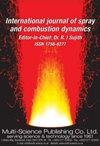Interaction of equivalence ratio fluctuations and flow fluctuations in acoustically forced swirl flames
IF 2.1
4区 工程技术
Q3 ENGINEERING, MECHANICAL
International Journal of Spray and Combustion Dynamics
Pub Date : 2021-06-01
DOI:10.1177/17568277211015544
引用次数: 5
Abstract
The generation and turbulent transport of temporal equivalence ratio fluctuations in a swirl combustor are experimentally investigated and compared to a one-dimensional transport model. These fluctuations are generated by acoustic perturbations at the fuel injector and play a crucial role in the feedback loop leading to thermoacoustic instabilities. The focus of this investigation lies on the interplay between fuel fluctuations and coherent vortical structures that are both affected by the acoustic forcing. To this end, optical diagnostics are applied inside the mixing duct and in the combustion chamber, housing a turbulent swirl flame. The flame was acoustically perturbed to obtain phase-averaged spatially resolved flow and equivalence ratio fluctuations, which allow the determination of flux-based local and global mixing transfer functions. Measurements show that the mode-conversion model that predicts the generation of equivalence ratio fluctuations at the injector holds for linear acoustic forcing amplitudes, but it fails for non-linear amplitudes. The global (radially integrated) transport of fuel fluctuations from the injector to the flame is reasonably well approximated by a one-dimensional transport model with an effective diffusivity that accounts for turbulent diffusion and dispersion. This approach however, fails to recover critical details of the mixing transfer function, which is caused by non-local interaction of flow and fuel fluctuations. This effect becomes even more pronounced for non-linear forcing amplitudes where strong coherent fluctuations induce a non-trivial frequency dependence of the mixing process. The mechanisms resolved in this study suggest that non-local interference of fuel fluctuations and coherent flow fluctuations is significant for the transport of global equivalence ratio fluctuations at linear acoustic amplitudes and crucial for non-linear amplitudes. To improve future predictions and facilitate a satisfactory modelling, a non-local, two-dimensional approach is necessary.声学强制旋流火焰中当量比波动和流量波动的相互作用
实验研究了旋流燃烧室中时间等效比波动的产生和湍流输运,并与一维输运模型进行了比较。这些波动是由喷油器处的声学扰动产生的,在导致热声不稳定的反馈回路中起着至关重要的作用。本文研究的重点是受声强迫影响的燃料波动和相干涡结构之间的相互作用。为此,光学诊断应用于混合管道和燃烧室内,容纳湍流漩涡火焰。通过对火焰进行声扰动,得到相位平均的空间分辨流动和等效比波动,从而确定基于通量的局部和全局混合传递函数。测量结果表明,预测注入器等效比波动产生的模式转换模型适用于线性声强迫幅值,但不适用于非线性幅值。燃料波动从喷射器到火焰的全局(径向积分)传输可以用一维传输模型很好地近似,该模型具有考虑湍流扩散和弥散的有效扩散率。然而,这种方法无法恢复混合传递函数的关键细节,这是由流动和燃料波动的非局部相互作用引起的。这种效应在非线性强迫振幅中变得更加明显,其中强相干波动导致混合过程的非平凡频率依赖。本研究解决的机制表明,燃料波动和相干流波动的非局部干扰对于线性声幅值下的全局等效比波动的输运具有重要意义,对于非线性声幅值至关重要。为了改进未来的预测和促进令人满意的建模,非局部的二维方法是必要的。
本文章由计算机程序翻译,如有差异,请以英文原文为准。
求助全文
约1分钟内获得全文
求助全文
来源期刊

International Journal of Spray and Combustion Dynamics
THERMODYNAMICS-ENGINEERING, MECHANICAL
CiteScore
2.20
自引率
12.50%
发文量
21
审稿时长
>12 weeks
期刊介绍:
International Journal of Spray and Combustion Dynamics is a peer-reviewed open access journal on fundamental and applied research in combustion and spray dynamics. Fundamental topics include advances in understanding unsteady combustion, combustion instability and noise, flame-acoustic interaction and its active and passive control, duct acoustics...
 求助内容:
求助内容: 应助结果提醒方式:
应助结果提醒方式:


